Lyme disease, and all the other tick borne illnesses are scary, especially if you're a forager. In this post I'll tell you how I prevent myself from getting lyme disease again. My secret is that I use permethrin-an extract from flowers that's the best defense against ticks I know.

Most of us are inside right now, but come May there will be more things to inspect for than morels. I'm talking about the growing legion of tick borne diseases: Lyme, Bebiosis, Erlichiosis, Tularemia Rocky Mountain Spotted Fever, and STARI the disease carried by the lone star tick, and possibly the worst of all of them, that can make you allergic to red meat. Yes, allergic to red meat (most sources just say beef and pork, but It's safe to assume more, too).
If that wasn't fun enough, there's also tick paralysis, which can affect the heart and lungs, causing death. Then, if you're doubly unlucky, like I was, your choice of blood-borne tick disease may interact and exacerbate pre-existing conditions permanently damaging your neurology, and, while it probably won't kill you, it could definitely make your life miserable enough to make you think of killing yourself. These are some of the tick-borne illnesses and side effects people who venture outside for fun are at risk for contracting, and if you're one of those people, you need to be aware.

A tick check is standard, but dangerous tick nymphs are so small you can barely see them with the human eye (see above). For all the ticks and the fear they instill in us, Permethrin--a topical insecticide widely used and supported by the Department of Natural Resources, is the best prevention I've found. I use the Sawyer brand or a bulk concentrate.

But, insecticides, pesticides? The words make my skin crawl, and make me think of things like Roundup and DDT, dead bald eagles, class action cancer lawsuits, and all the things we humans have really messed up with the goal of controlling nature. Generally speaking, I don't like chemicals, I don't even like standing next to people that use conventional detergent and softener sheets--the smell is nauseating to me.
Natural vs Synthetic
Many of you are already familiar with it, if you're not, here's the skinny. Like many insecticides, permethrin is a synthetic compound modeled after a natural one, in this case, it's one of a number of chemicals known as pyrethroids, named for their being based on pyrethrum--an extract from crushed chrysanthemum flowers historically used as a natural, topical insecticide to treat things like body lice.
Pyrethrum, like you might expect, is less powerful than permethrin, and more quickly broken down back into nature after it's used.
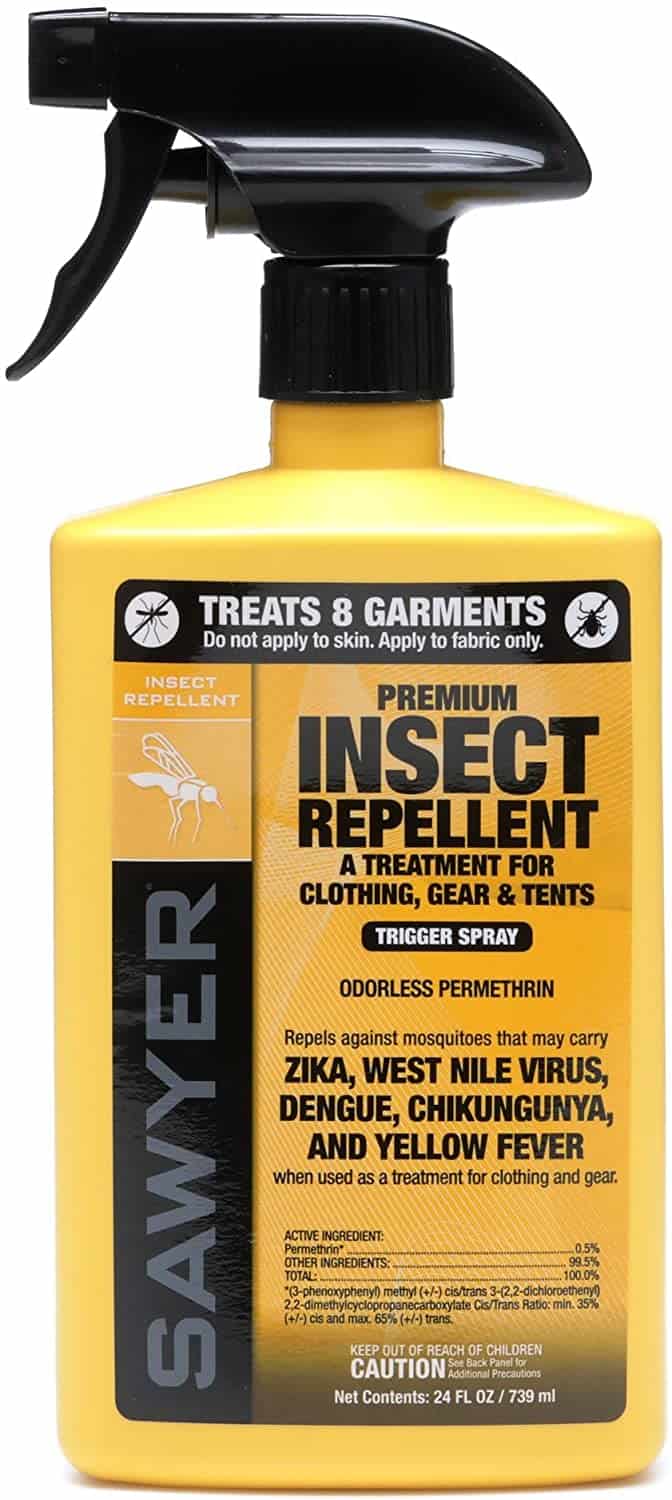
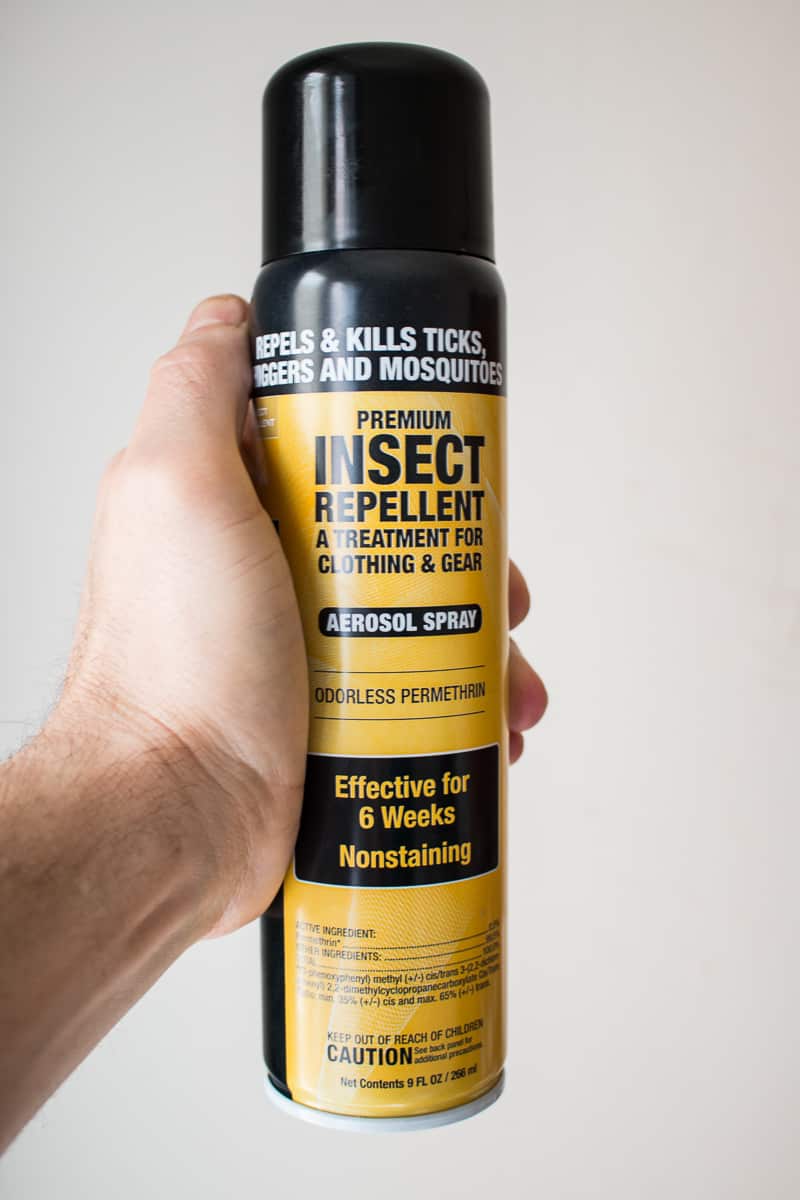
Liquid or aerosol permethrin=lethal to cats, bees, and fish
What permethrin does, when used correctly, and it does it very well, is kill and repel ticks. Unfortunately, if not used correctly, it can also kill other things, and both natural pyrethrum and synthetic permethrin are toxic, and potentially lethal to cats, bees, and aquatic life, which brings us back to the phrase "when used correctly".
Note too that the mortal form for those creatures is the liquid, or aerosol spray. Fluffy isn't going to die from coming in contact with a pair of socks you've treated, dried and worn. So, for the record, don't spray the bee hive or fluffy, and don't dump it in the river when you're trout fishing.
How it's used
For me, this involves heavily spraying an outfit including a shirt and pants while wearing a mask outside about once a month during the growing season, at the cost of about 12$ a month, simply following the guidelines on the container (I do it every 4-5 weeks instead of 6 to be safe and account for human calendar error).
After the outfit is sprayed, you set them to dry naturally. Afterwords, your tick suit needs no other attention for a month, or a couple washes--whichever comes first. There's no constant spraying like deet, and no rubbing it into your skin. You can also buy a concentrated form, and dip your clothes, then dry, which removes the airborne spray application from the equation. Look for concentrated forms at your local farm/fleet type store. I'm going to outline the dilution method below.
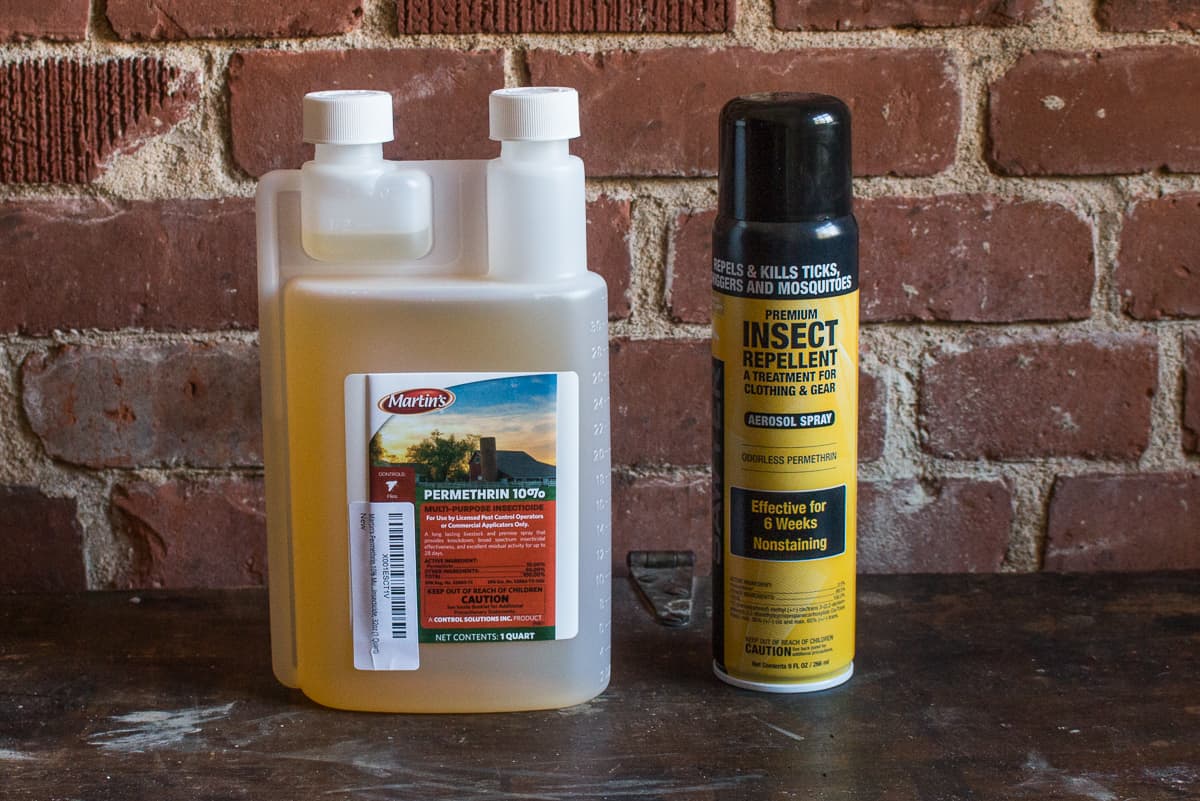
How to treat your clothes
The cheapest way to use permethrin, as well as not involving spraying anything, is to dilute a concentrate like pictured above (10%) into the same concentration as the spray bottles (.5%). To do that, we have to harness a special power, that of the ancient art of algebraic fractions. Luckily for you, a group of friends and I did the math for you.
Math
To dilute a concentration of 10% permethrin to .5%, I started with the goal of using 1 gallon of water to soak a batch of clothes. While I did the fractions and cross multiplication, it's easier to explain here with simple percentages.
If there's 32 oz in one quart, and that is 10% concentration, then a 1% concentration would be 3.2 oz. From there, a .5% concentration is 1.6 oz, so 1.6 oz of the permethrin concentrate in one quart gives us a .5% solution. From there, we just need to multiply a quart by 4 to get the needed dilution of 1 gallons to come in at .5%
1.6 oz of concentrate x 4 quarts = 6.4 oz of concentrate in 1 gallons for a .5% solution.
MASTER FORMULA
For 1 gallon of liquid ready to soak clothes, you'll add 6.4 oz of 10% concentrate or roughly ¾ cups plus 1 tablespoons to 1 gallon of water.
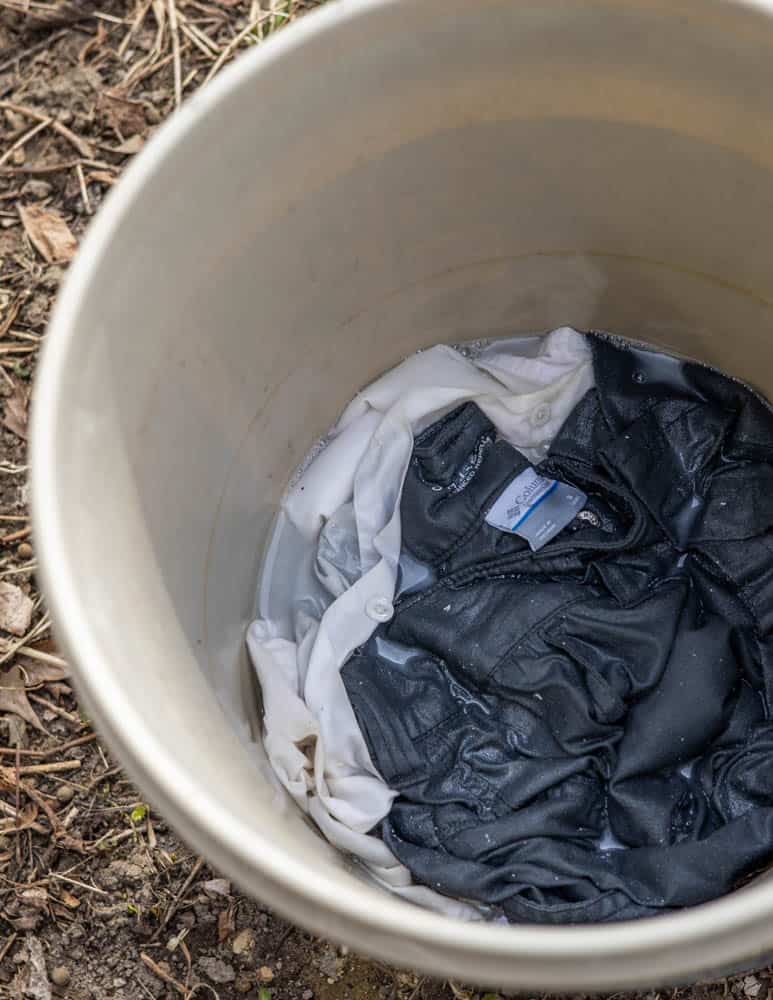

How to soak or spray treat clothes with permethrin
Ingredients
Permethrin Mixture
- 1 gallon For 1 gallon of liquid ready to soak clothes, you'll add 6.4 oz of 10% concentrate or roughly ¾ cups plus 1 tablespoons to 1 gallon of water.
- 6.4 oz (¾ cup plus 1 T) 10% permethrin concentrate
- Clothing. You can soak socks, shirts, pants, hats, anything. I usually only soak shirts and pants.
Instructions
Spraying clothes with permethrin
- Lay out some clothes outside or in a very well ventilated area. Spray the clothes according to the manufacturers directions, completely saturating them on both sides.
- Hang the clothes to dry until completely dry. I keep them separate from my other clothes.
Soaking clothes with permethrin
- Measuring the permethrin with a container you don't use with food, weigh out 6.4 oz of 10% concentrate and mix with 1 gallon of water in a 10 gallon bucket or similar container dedicated for the purpose of soaking your clothes. I keep my bucket in the garage, it is only used for soaking clothes with permethrin.
- Using waterproof gloves, soak the clothes completely in the permethrin water, then remove to dry outside on a line to dry naturally.
- When your clothes are completely dry, remove them, and keep in a place dedicated for them, like a bag, box, etc.
General info
- When you'll be going outside and will be exposed to ticks, wear the outfit. You can wash it normally, but after 2-3 washes the permethrin will be gone. Without washing the permethrin may last much longer, especially if the clothes were soaked vs sprayed. I usually soak my clothes every other month, and it's likely overkill.
- I also keep my outfits together, separate from my other clothes.
- Some of my friends claim to have used one outfit without washing for an entire season without seeing ticks.
- Every two months, re-soak the outfits, repeating the soaking and drying process. See the notes for how to dispose of permethrin.
Notes
How to Dispose of Permethrin
Permethrin should be treated as a hazardous household waste. If disposing of it makes you uneasy, remember you can always use the spray as an alternative. The first way to dispose of permethrin is to bring it to your local collection center. If you don't want to bring it in, you can leave it in a bucket and let it dry out, or cover any remaining liquid with a tight fitting lid and save for more clothes in a garage or shop.Why use it?
Many of you know that I had Lyme disease. It's been 7 years since it happened, and I'm thankful that I was able to get the antibiotics in me before the spirochet wriggled it's way into my spine. Terrified I'd never go outside again, a close friend of my mother who works for the D.N.R. in Minnesota recommended permethrin to me, which was

what he and his colleagues used. If it worked for the D.N.R. I thought, I could try it out. So, I gave it a shot, and to this day, seven years later, I have spent more time in the woods than I ever though possible for one person, and I can probably count on one hand the ticks I've seen since I had Lyme, and most of those probably crawled on me from the dog.
Nothing, and I repeat, nothing, I have found or heard of, works like permethrin. Deet needs to be continually applied (sometimes I wonder if it works at all) and things like essential oils, to me, are a joke (don't get me started on the multi-level-marketing shemes used to sell many of them, either).
Is It Dangerous?
Like I mentioned, permethrin is lethal to cats, birds, and bees, so don't spray them with it. In the scheme of things though, lots of things we use or have used are dangerous. DDT is a good example.
The problem with DDT was that it persists in the environment, concentrating in fish that bald eagles ate, and, as the compound stayed in their system, it eventually denatured eagle egg shells and increased bird mortality. Permethrin is a little different, and it's half life is a far cry from DDT. There's also no evidence I can find that it harms wildlife after it's been used correctly.
From the National Pesticide Information Center
"The average half-life range for permethrin in the water column is about 19-27 hours, however permethrin adsorbed to sediments can persist more than a year. Permethrin is not likely to contaminate groundwater due to its low water solubility and strong adsorption to soil."
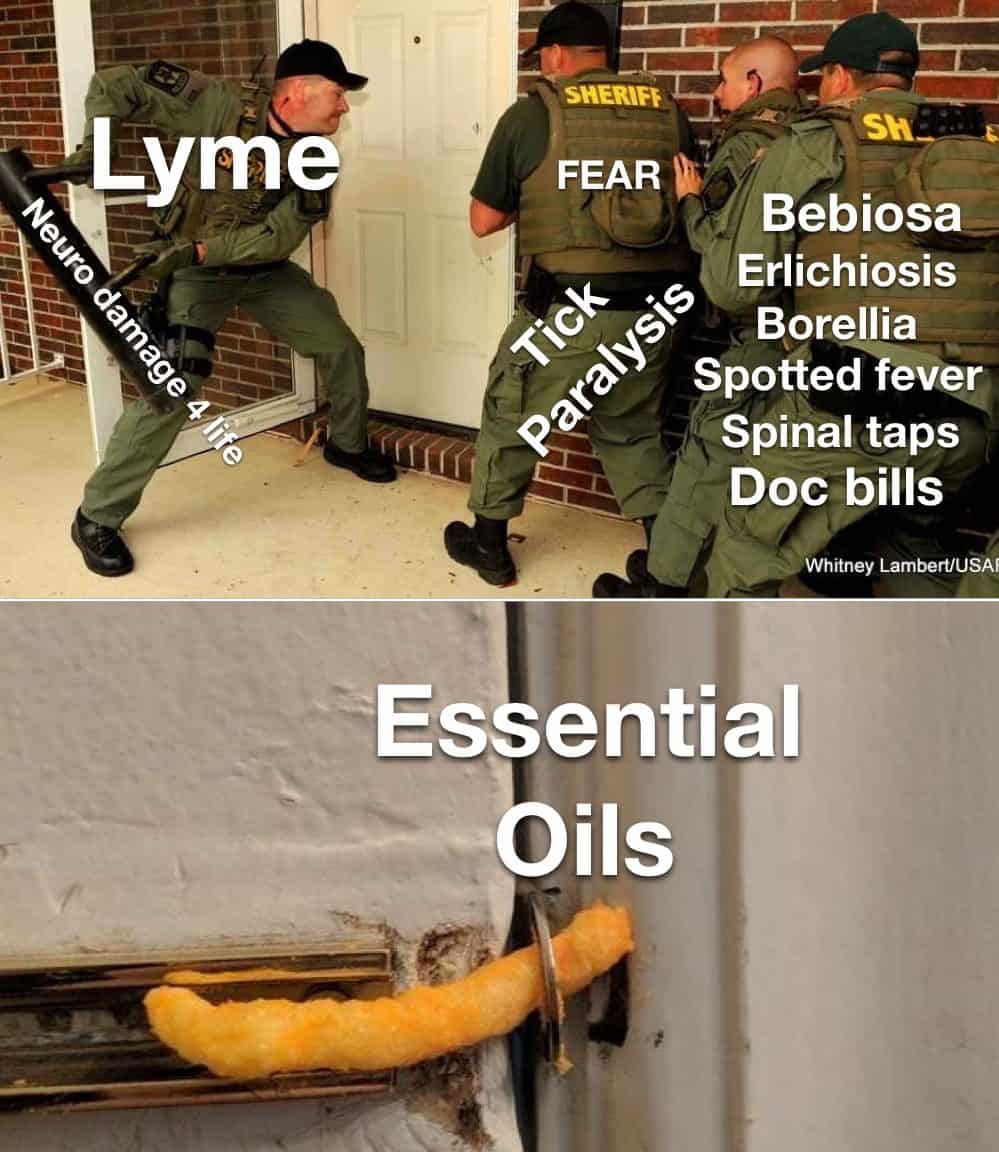
Don't Ingest it
Another good rule of thumb with chemicals is not good to ingest them, or rub them all over your body, or generally misuse them. Permethrin and deet are both widely used, and, like other similar chemicals, if there's some glaring issue, you'd expect there to be a little information, at least anecdotal, out there to peruse.
With deet, there is, and it's pretty much what you'd expect: a few cases here and there of people getting sick or developing a rash, most of them coming from people abusing or misusing the product.
Unfortunately, with Permethrin, there's only a few blips here and there--not a lot of information, besides one case of a woman's fetus developing Leukemia since she had arachnophobia, and (presumably) drastically overused the product inside her home. But, before we throw it out the door as a carcinogen because of a single case out of millions of users, remember there's plenty of things people claim are carcinogens.
Like with a lot of things, dosage is super important. Eating a couple teaspoons of Cassia cinnamon a day will 100% bring you to a toxic threshold of coumarin, the compound which was also used to make medical drugs like Warfarin. Cherry and plum stones contain cyanogenic glycosides, and if you eat enough raw, they're toxic too, although edible, with uses dating back thousands of yeas. Balance in all things.
Saving lives: Malaria, Zeka, Dengue, West Nile and others
If you're skeptical, consider that permethrin, besides killing ticks, also repels mosquitos that carry things like Zeka and West Nile Virus. The Oxford Academic journal link in the resources below outlines how insecticides like permethrin can be used to curb those diseases, for which there are no vaccines.
In our current climate of Coronavirus, we've all seen how a lack of a vaccine can work and bring society completely to it's knees. For diseases like that, spread by mosquitos, repellents and insecticides may literally be the only effective preventative measure we have to save people at this time. Since those products are already at work around the world saving lives, it's a good idea to balance those sort of positives with any drawbacks, while we wait for the miracle tick-disease cure.
In closing, I've tried to gather some helpful information here to really explain to people why I use and support this stuff. Permethrin, insecticide that it is, was the only thing that gave me courage to go outside after my experience with Lyme, and, if you've been wondering about it, I hope my account can help you.
Resources and Further Reading
Tick Tick...Boom. Minnesota Conservation Volunteer
National Center for Biotechnological Information: Carcinogens


Sam Murdoch
I post this comment without knowing what I'm talking about. Hoping that someone knowledgable - Alan - can say for sure or will ask around for a definitive answer.
SO - without any substantiating evidence it occurs to me that spraying is better than soaking as a long term practice BECAUSE spraying reduces the amount of permethrin contact with your skin. All well and good to spray the outside of your clothing but saturating to the inside too, seems problematic. Yes, I understand, the clothing is worn dry but then as you move about and start to perspire ...
I guess, all good to soak outer garments that won't be in contact with the skin but we aren't likely to wear outer garments in the summer in the US.
Should we be concerned?
Thanks for an excellent informative post.
Alan Bergo
HI Sam Sorry I was pokey getting to you here. Soaking the garments is essentially the same as pre-treated garments sold in stores like REI. I choose to soak as I prefer not to spray. But, sometimes I may do either.
brian brandt
Please note the actual percentage of deer ticks carrying lyme is over 99%. I've seen actual data (Ottertail County is 100%). The data was purposely manipulated to prevent the destruction of tourism. My Dr. did the testing.
Alan Bergo
Thanks Brian.
Jeff Wala
I had a higher percentage of deer ticks show up among the wood ticks this spring on my property in northern Wisconsin. There is a tick center at a clinic in Woodruff that will take ticks brought in and send them to a lab to test for something like a dozen strains of harmful bacteria. I did this for piece of mind for guests. It came back negative for all. I would suggest anyone concerned look for a similar service in their area, rather than rely on random statistics dropped into social media. One caveat is that it cost $50 per tick, but if there are a number of concerned people in an area, pooling resources to do a few tests would help guide how much caution (and chemicals) are appropriate in your area.
Alan Bergo
Thanks Jeff. I like that idea, but as someone who’s had Lyme I think it could give you a false sense of security. I think it would be highly unlikely a property that has deer ticks is safe enough to disregard them just because a few were tested. It’s all good, until it isn’t.
Oliver
Hello, does anyone know a reliable seller that would ship Permethrin to Canada?
William Hunter Duncan
I had Lymes the last time the Market collapsed, in the Fall of 2008. I went a bit crazy, quit my fancy corporate job,, jumped in my girlfriend's (at the time) 1979 Volkswagon Dasher diesel running on veggie oil - while the world bailed out the Masters of the Universe and left us all twisting in the wind - communing in Mendocino with the redwoods, spending my days on the beach and in the woods hunting mushrooms and berries, otherwise reading and healing.
Years after, reflecting on that, I wrote this for the blog I was maintaining:
https://offthegridmpls.blogspot.com/2012/06/lyme-disease.html
Everything after Lymes changed for me. Maybe I it was just the face of mortality that made me Question Everything? Maybe it was just a combination of walking away, the antibiotics and the three months of self care? Maybe the bacteria was just a catalyst? Or maybe it was and is something more?
Today, sitting in my sunroom in Minneapolis, reflecting on how quiet the city is this Monday, how the economy has ground to a halt, I wonder to what degree this corona virus is a catalyst for change? It seems to me 2020 is a fine time for reflection. While official Washington tries to figure out how to institutionalize crony capitalist inequality, ala 2008, throwing the proverbial dogs a few bones, perhaps it is time for the people to take a step back, reevaluate, and make change? Not just society wide - more focus on local production of essential products, particularly food, with a deeper respect for ecology, and no more socialism only for the elite - but also within, of the self. What changes have I needed in my own life are facilitated now by this shutdown? It seems a very fertile time for change, to me.
Alan Bergo
Absolutely--a fertile time for change indeed. I try not to stare at the screens every day for too long since it's depressing, but the human part of me can't help but watch a little too. I'm really anxious to see how all my friends in the hospitality business come out after this, just about everyone I know is down and out.
Bethany Ringdal
My worry has been about fish... my outdoor life involves walking through lots of natural waterways. Do we feel pretty good about this stuff not coming off in a stream?
Alan Bergo
Hi Bethany, so, since you spray it on your clothes, and let it dry, there's no way Permethrin could get into a stream. But, if you're a fly-fisherman, I wouldn't spray your waders with it and then stand in the water.
Laurie
You can also buy clothing that has been treated for you and send it back to be treated again after the garment has lost it's effectiveness through washing. I wish I could use these items but I sweat heavily. Although morel season for me is fairly cool, once it gets hot in New England, it's also humid, and I have to get by on the least amount of clothing possible. I could wear treated socks, and maybe shoes but that's it. I find it's grasses and shrubs that ticks use to find their hosts, at a height of about mid-calf for me. Hmmmm, maybe I could stand knee socks?
Alan Bergo
Hey Laurie, you bet. I wear long sleeves and pants all year in Minnesota. It gets hot and humid here like where you live, and yes, that's a sacrifice to mention. When you have the confidence to know that you won't see a single tick after literal days in the woods, you make sacrifices. As Ellen mentioned, the peace of mind is more valuable than a lot of people realize. I'm sure you could figure out a compromise. You could treat long socks and shoes, for example.
Laurie
Thanks Alan. I forgot to mention that my residence lies in the southeastern corner of Connecticut, about half an hour away from the town of — you guessed it — Lyme. I have had it twice myself, but fortunately had mild symptoms comparatively speaking. Because of the sweating factor, I’ve relied on daily baths or hot showers and sleeping naked to avoid embedded ticks. Still, one found a comfy spot on the top outer edge of my ear this fall. I had it tested and the tic was negative for Lyme.
My friend who hikes a lot buys the treated clothing. He loved your piece and said he will forward it to fellow hikers. And I will strong consider the treated socks and shoes. (Useful especially for leaf cleanup where I often get them).
Claudia Y. Marieb
Thanks for the great post. I'm curious about the clothes that you use - your foraging outfit.
Do you wear long pants tucked into socks, long sleeves? or is the permethrin strong enough that if some skin shows, (e.g. if you wear long shorts), the ticks still don't imbed or at least don't crawl up into the clothed area?
Alan Bergo
Claudia, that's a great question. I wear long sleeves, long pants. All year. Light weight stuff though, the lightest material I can find, typically stuff from REI. With the permethrin, there is no need to tuck your pants into your socks--one of the benefits of the peace of mind.
Claudia Y. Marieb
Thanks Alan. It IS hard to do on the hot humid days, but I will go with your recommendation for sure. It's nice to not have to tuck into the socks at least so look like less of a dork. I've been on the fence about using permethrin and your post helped me go ahead and order some. My best morel spot is loaded with ticks and every year I have at least one imbedded tick and a lyme disease scare. Am looking forward to a season with more peace of mind. Thanks again!
Paul Ostrander
Thanks for the reminder Chef! i purchased an extra large can of Permethrin and plan to spray my Mushroom foraging
clothes with it. I had a Dog Tick on the top of my head just starting to burrow into my scalp and caught it early. I don't have any issues from it.
Alan Bergo
Glad you caught it early.
Ellen Zachos
I've had Lyme, too. Caught it in time not to have any long lasting effects...as far as I can tell! As a forager, I just assumed ticks were something I had to accept; it wasn't unusual to come back from a walk and pull 30 of them off me. Last summer in PA I did the permethrin soak. I kept one set of clothes just for foraging, soaked them good, never washed them (not once, the whole summer) and get this: I didn't have a single tick on me all year. What a difference that made to my foraging psyche! I didn't realize how much I'd been worrying about it, but once you've had Lyme, you worry. It made a world of difference to how I felt about being outdoors and I can't believe I didn't do it sooner. I tracked the soak down at the local Tractor Supply. It was less expensive than the spray and worked like a charm. I will ALWAYS soak from now on.
Alan Bergo
Thanks Ellen, I've been on a misson to find the soak concentrate and noone carries it in my area. Yeah, once you've seen what the Lyme can show you, you don't want to see it again.
Loren Danson
Concentrated Permethrin can be found at Tractor Supply and probably Fleet Farm in Minnesota. Look in the livestock section, however it isn't labeled for use in treating clothing.
Alan Bergo
Thanks, that’s great to know. But, the “not labeled for clothes” part makes me think twice, I’ll ask Ellen about which one she buys.
Loren Danson
The Martin's 10% Permethrin you have pictured in your blog clearly says for commercial use only on the front label. A quick google search of it's label shows it is also not labeled for treating clothes. I'm not against this practice, just be careful what you promote in your blog. We live in a very litigious society.
Alan Bergo
That's exactly why I wrote in the caption of the image "A concentrate you can spray outside". But I can see how that could be misconstrued, thanks for pointing it out. I'm changing the description.
Marty Horn
Excellent Post!
We use it by label directions and it flat works great. Have a specific set of clothes designated for outdoor activates. We scored on 80 morels Thursday and never got a tick and believe me they are thick here. Turkey season starts pretty quick and a treated hat keeps the mosquitoes off my face.
Alan Bergo
Thanks Marty, got a lot of time before we get morels up here in Minnesota. Glad it works for you.
Gene Kremer
The proper usage is on the label, but a lot of people don't read labels . Mainly1. this means:
1. Treat clean clothes ( do NOT add to wash water).
2. Outdoors or with VERY good ventilation, spray the clothes.
3. Let them dry.
4. For best results, repeat 2 and 3.
5. WAIT until they are completely dry before wearing them.
That should do you for several washings.
Like any pesticide, keep away from animals, children,....
Dispose of the empty containers as hazardous waste.
Alan Bergo
Thanks for the reminder Gene.
Elizabeth Blair
I HAVE HAD LYME TOO. THREE TIMES. THE THIRD TIME I HAD BELLS PALSY WITH IT BUT CAUGHT IT SOON ENOUGH FOR ONE WEEK'S USE OF ANTIBIOTIC TO MAKE THE BELL'S PALSY DISAPPEAR. I have not had a tick on me since the last case in 2015, when I contacted the DNR and they recommended PermethrIn. I have used it ever since. I spray my clothes outside on the line but only when there's no wind. Masks are a good idea - but where can we get them these days?
Some of my friends claim they're "allergic" to permethrin, get a red rash from it, and won't use it. Do you know anything about that issue? I have never had a problem myself. Thanks for sharing your experience with us. And yes, it's been my experience too that a lot less misquotes visit when wearing treated clothes.
Alan Bergo
Ugh, the palsy was the worst--I've heard some people keep the paralysis for life which terrified me. As far as masks, I have one I saved but yeah, going to be hard to find now days. I've tied a rag around my face in a pinch before. I've never gotten a rash from it, but I don't use the type that you apply to skin--I know they're are some types of permethrin that are used topically directly on the skin, or dogs. I'd say, just like any new food or substance, people can obviously have different reactions.